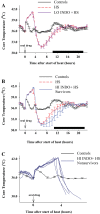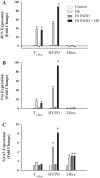Pretreatment with indomethacin results in increased heat stroke severity during recovery in a rodent model of heat stroke
- PMID: 28596269
- PMCID: PMC5625077
- DOI: 10.1152/japplphysiol.00242.2017
Pretreatment with indomethacin results in increased heat stroke severity during recovery in a rodent model of heat stroke
Abstract
It has been suggested that medications can increase heat stroke (HS) susceptibility/severity. We investigated whether the nonsteroidal anti-inflammatory drug (NSAID) indomethacin (INDO) increases HS severity in a rodent model. Core temperature (Tc) of male, C57BL/6J mice (n = 45) was monitored continuously, and mice were given a dose of INDO [low dose (LO) 1 mg/kg or high dose (HI) 5 mg/kg in flavored treat] or vehicle (flavored treat) before heating. HS animals were heated to 42.4°C and euthanized at three time points for histological, molecular, and metabolic analysis: onset of HS [maximal core temperature (Tc,Max)], 3 h of recovery [minimal core temperature or hypothermia depth (HYPO)], and 24 h of recovery (24 h). Nonheated (control) animals underwent identical treatment in the absence of heat. INDO (LO or HI) had no effect on physiological indicators of performance (e.g., time to Tc,Max, thermal area, or cooling time) during heating or recovery. HI INDO resulted in 45% mortality rate by 24 h (HI INDO + HS group). The gut showed dramatic increases in gross morphological hemorrhage in HI INDO + HS in both survivors and nonsurvivors. HI INDO + HS survivors had significantly lower red blood cell counts and hematocrit suggesting significant hemorrhage. In the liver, HS induced cell death at HYPO and increased inflammation at Tc,Max, HYPO, and 24 h; however, there was additional effect with INDO + HS group. Furthermore, the metabolic profile of the liver was disturbed by heat, but there was no additive effect of INDO + HS. This suggests that there is an increase in morbidity risk with INDO + HS, likely resulting from significant gut injury.NEW & NOTEWORTHY This paper suggests that in a translational mouse model, NSAIDs may be counterindicated in situations that put an individual at risk of heat injury. We show here that a small, single dose of the NSAID indomethacin before heat stroke has a dramatic and highly damaging effect on the gut, which ultimately leads to increased systemic morbidity.
Keywords: NSAID; heat stress; heat stroke; hyperthermia; mouse.
Figures








Similar articles
-
Increased cytokine and chemokine gene expression in the CNS of mice during heat stroke recovery.Am J Physiol Regul Integr Comp Physiol. 2013 Nov 1;305(9):R978-86. doi: 10.1152/ajpregu.00011.2013. Epub 2013 Sep 11. Am J Physiol Regul Integr Comp Physiol. 2013. PMID: 24026076
-
Prior viral illness increases heat stroke severity in mice.Exp Physiol. 2021 Jan;106(1):244-257. doi: 10.1113/EP088480. Epub 2020 May 19. Exp Physiol. 2021. PMID: 32362011
-
Cardiovascular and thermoregulatory biomarkers of heat stroke severity in a conscious rat model.J Appl Physiol (1985). 2014 Nov 1;117(9):971-8. doi: 10.1152/japplphysiol.00365.2014. Epub 2014 Aug 14. J Appl Physiol (1985). 2014. PMID: 25123200
-
The pathopysiology of heat stroke: an integrative view of the final common pathway.Scand J Med Sci Sports. 2011 Dec;21(6):742-8. doi: 10.1111/j.1600-0838.2011.01333.x. Epub 2011 Jun 2. Scand J Med Sci Sports. 2011. PMID: 21635561 Review.
-
Controversies in exertional heat stroke diagnosis, prevention, and treatment.J Appl Physiol (1985). 2019 Nov 1;127(5):1338-1348. doi: 10.1152/japplphysiol.00452.2019. Epub 2019 Sep 23. J Appl Physiol (1985). 2019. PMID: 31545156 Review.
Cited by
-
Classic and exertional heatstroke.Nat Rev Dis Primers. 2022 Feb 3;8(1):8. doi: 10.1038/s41572-021-00334-6. Nat Rev Dis Primers. 2022. PMID: 35115565 Review.
-
An acute naproxen dose does not affect core temperature or Interleukin-6 during cycling in a hot environment.Sports Med Health Sci. 2021 Sep 1;3(4):243-251. doi: 10.1016/j.smhs.2021.08.004. eCollection 2021 Dec. Sports Med Health Sci. 2021. PMID: 35783372 Free PMC article.
-
Timing and Predictors of Mild and Severe Heat Illness among New Military Enlistees.Med Sci Sports Exerc. 2018 Aug;50(8):1603-1612. doi: 10.1249/MSS.0000000000001623. Med Sci Sports Exerc. 2018. PMID: 29613996 Free PMC article.
-
Non-steroidal anti-inflammatory drugs on core body temperature during exercise: A systematic review.J Exerc Sci Fit. 2021 Apr;19(2):127-133. doi: 10.1016/j.jesf.2020.12.003. Epub 2021 Jan 6. J Exerc Sci Fit. 2021. PMID: 33552178 Free PMC article. Review.
-
The Gastrointestinal Exertional Heat Stroke Paradigm: Pathophysiology, Assessment, Severity, Aetiology and Nutritional Countermeasures.Nutrients. 2020 Feb 19;12(2):537. doi: 10.3390/nu12020537. Nutrients. 2020. PMID: 32093001 Free PMC article. Review.
References
MeSH terms
Substances
LinkOut - more resources
Full Text Sources
Other Literature Sources
Research Materials

